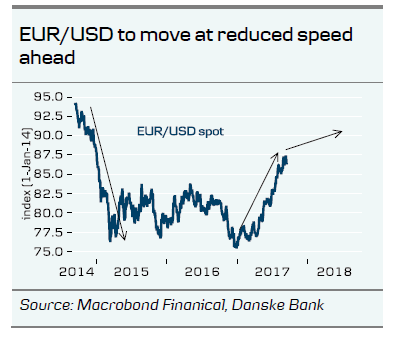- No hike but Fed will announce it will begin shrinking its balance sheet in October. This is widely expected and should not have a major impact on Treasury yields.
- We expect the median ‘dots’ to still signal one more hike this year and three hikes next year. The longer-run median ‘dot’ may be revised down from 3% currently.
- We do not expect major changes to the statement, as it already says the Fed monitors inflation ‘closely’. We are looking forward to hearing Janet Yellen’s view on the dilemma with low inflation and unemployment at the same time.
- Any dips in EUR/USD will be shallow and short-lived but we emphasise that the speed with which EUR/ISD is set to move higher will be reduced going forward.
No Fed hike but announcement on balance sheet reduction
Next week’s meeting is one of the so-called big meetings, which means that we get updated projections and there will be a press conference after the policy announcement. We do not expect the Fed to increase the target range but instead expect it to announce that ‘quantitative tightening’ is set to begin in October. This is widely expected and should not by itself lead to significant market reaction, as the Fed has outlined most details already. The Fed is expected to decrease reinvestments by gradually increasing caps on the amount of bonds that will be allowed to run off each month and only reinvest the amounts that exceed the caps each month. For Treasuries, the cap will begin at USD6bn per month and increase by USD6bn at three-month intervals until it reaches USD30bn per month. For mortgage-backed securities, the cap will be set at USD4bn per month initially and increase USD4bn at three-month intervals until it reaches USD20bn per month. We do not expect quantitative tightening to have a major impact on Treasury yields like the taper tantrum in 2013. The Fed will still have a significant reinvestment need in 2018, but there is a risk that quantitative tightening could lead to an unwarranted tightening of financial conditions. The reason is that we still do not know what level the Fed targets for the balance sheet, which, in our view, is not a trivial question due to increasing regulation, something the Fed has also touched upon previously.
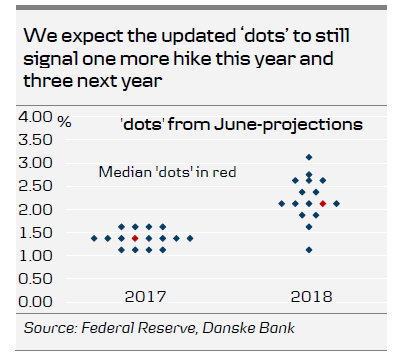

Fed likely to still signal a third hike
Besides the announcement on quantitative tightening, focus is on changes to the so-called ‘dot’plot and the FOMC statement, mainly because of the Fed’s dilemma with low inflation and low unemployment at the same time. While the dovish and hawkish camps have drifted further apart, we expect the median ‘dot’ to still signal a third hike this year, as we do not think four Fed members will lower their forecast (which is the necessary number in order to lower the median ‘dot’). In June, there were already four members (probably Bullard, Brainard, Evans and Kashkari, in our view) indicating no further hike this year but based on recent speeches it seems like only Kaplan may have joined them, although not all Fed members have expressed their opinions lately. In our view, Dudley’s support for further tightening was key, as he is one of the core members of the FOMC (number three after Yellen and Fischer). Dudley argued that financial conditions are very easy and that above-trend growth should put upward pressure on inflation due to the tighter labour market. For the same reason, we think the median ‘dot’ will continue signalling three hikes next year. That said, it is important to stress that while all FOMC participants are submitting their projections, only nine of them have voting rights, meaning that the ‘dots’ are likely to be biased in a hawkish direction, as many of the most hawkish Fed members are non-voters. Also, note that we for the first time will get ‘dots’ for 2020.
With respect to the longer-run dot, it is interesting to take note of the theoretical debate within the Fed about the level of the so-called neutral rate (simply put, it is the rate which should prevail when the output gap is closed and growth is on trend), which the longer-run dot should reflect. In his most recent speech, Kaplan mentioned he believes the long-term neutral rate is closer to 2.25% than 3.0% (the current median longer-run median dot). This statement could be an indication that the longer run ‘dots’ may be revised down. This is very interesting, as it says something about how high the Fed thinks the interest rates should go eventually (unless the Fed at some point feels the need to increase the Fed funds rate above the neutral rate) and hence at what levels US yields should trade. Estimates of the current level of the neutral rate are lower than the 3% and Fed Chair Yellen has also said that the 3% is based on the expectation of an increasing neutral rate due to higher productivity growth. As Yellen thinks monetary policy is currently close to neutral (meaning that the current Fed funds rate is close to the current neutral rate), hikes further out from end-2018 onwards are due to an increasing neutral rate. If the neutral rate does not increase, it means that the hiking cycle may end sooner than most analysts expect. It seems like markets buy into that story given the very soft pricing of the Fed, partly reflecting that investors do not expect a pickup in the neutral rate in coming years.
No major changes to inflation wordings despite low inflation
In the FOMC statement, we will look for any new wordings on inflation, as low inflation remains the biggest obstacle for hiking further since growth remains above trend and employment continues to rise. In July, the statement was changed from saying inflation ‘is running SOMEWHAT below’ 2% (our own emphasis) to just ‘running below’, which was interpreted as a smidgen dovish. Since then PCE core inflation has moved lower but the CPI data for August were more promising, as CPI core rose +0.2% m/m (and close to 0.3%), the biggest increase since February. Statements do not change much from meeting to meeting and we do not expect major changes at this meeting either, although risk is skewed towards a more dovish stance. We think the statement will continue to say that the Fed is monitoring inflation ‘closely’. More interesting is Yellen’s press conference as in June she expressed confidence in the Phillips curve. However, if inflation continues to disappoint while labour market continues to tighten, it may be harder for her to justify this conviction. We do not expect big changes to the statement with respect to growth and the labour market.
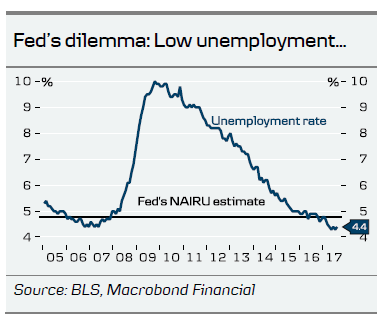

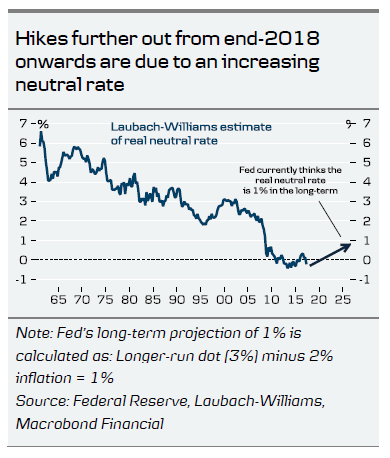

We expect the Fed to hike in December
Our base scenario is that the Fed will hike in December, mainly because the Fed puts more weight on labour market data relative to inflation. However, as we already mentioned after the June hike (see FOMC Review: Hawkish Yellen ignores inflation and weaker data, 15 June), a December hike is a close call and we estimate the hike probability to be 55% currently, as inflation remains low despite the stronger-than-expected CPI data for August. That is why since the June meeting, we have argued that risk is skewed towards the Fed pausing its hiking cycle due to low inflation, which may not be just ‘transitory’ given the low inflation expectations. In our view, the problem is that the tightness of the labour market is not the only factor determining wage growth, as second-round effects after many years with low inflation have hit wage growth. When employees expect inflation to remain low, they can live with low wage growth, as real wage growth may still be solid, making it less likely inflation will reach the target (see also Strategy: Central banks consider leaving the party, 30 June). In this regard, it is interesting that four FOMC members indicated that they do not expect the Fed to hike more this year in the June projections. Markets price in a December hike with a 45% probability. Less than 1.5 hikes are priced in by the end of next year.

Uncertainty about Fed policy next year
On at different note, it has become more difficult to say what the Fed will do next year. With Stanley Fischer stepping down on or around 13 October, there will be four vacant seats (Randal Quarles has been nominated but not approved yet) and possibly five if Yellen is not reappointed Fed Chair, which is not our base case. This means Trump has the power to shape the Federal Reserve in the way he wants (although the Senate has to approve his nominations). Although Trump does not seem very interested in monetary policy, the Republican Party certainly is, as many Republicans are dissatisfied with the Fed’s low rate policy. Many Republicans want a more rule-based Fed, which bases its monetary policy decisions on a policy rule (a simple Taylor rule suggests the Fed funds rate should be around 3% at the moment). In other words, we might see a more hawkish and rule-based Fed next year but the uncertainty is high.
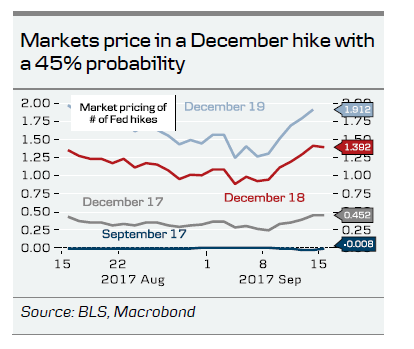
FX: Fed to cap EUR/USD upside near term
With a Fed set to confirm its intentions to hike rates once more this year and in light of a market that is clearly not prepared for this, it would be tempting to conclude that EUR/USD should come lower near term. But not so fast: relative short-end rates have not been a key driver of the FX market in the year so far – rather ‘euro optimism’ and an associated shift in ECB policy have been essential for the cross. That said, speculative positioning is closing in on stretched levels for EUR/USD longs, suggesting the vulnerability of the FX market to USD-positive news is greater than ‘normal’ at present. Thus, if US activity continues to surprise on the upside in Q4 – as our quantitative business-cycle model suggests it will – the pricing of a December hike could gain traction, and the FX market is unlikely to be immune to this. Fed balance-sheet reduction should not play a major role for USD crosses spot near term as it is well anticipated and as a rebuild of the Treasury cash buffer (which could add to tighter USD liquidity) has now been postponed, see FX Strategy: The return of USD scarcity – postponed, 7 September 2017. Even if ‘pockets’ of USD strength could materialise near term, we note that it is currently somewhat difficult for the market to send US yields higher due to the weak inflation prints recently, i.e. a key Fed obstacle. Thus, we reiterate our call that any dips in EUR/USD will be shallow and short-lived, but, at the same time, emphasise that the speed with which EUR/USD is set to move higher will be reduced going forward.
